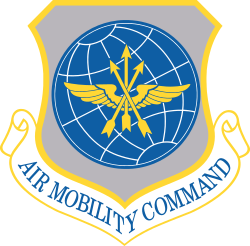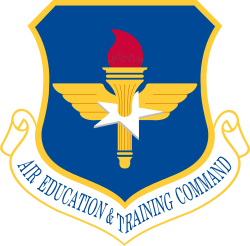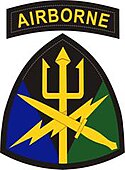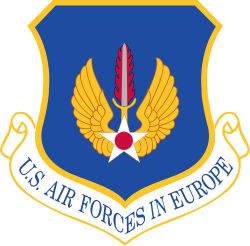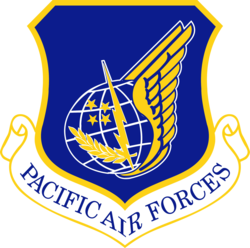Air Combat Command
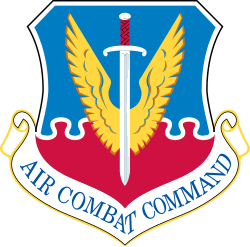
Das Air Combat Command (ACC; deutsch Luftkampfkommando) ist das größte von zehn Hauptkommandos der United States Air Force (USAF), mit Hauptquartier auf der Langley Air Force Base, Virginia. Sowohl aufgrund der umfangreichen Einsatzprofile als auch wegen der hohen Anzahl an Flugzeugen und Soldaten ist das ACC das bedeutendste Hauptkommando und bildet den Kern der USAF. Befehlshaber ist seit Februar 2024 General Kenneth Wilsbach als Nachfolger von Mark D. Kelly.
Geschichte
Das Air Combat Command wurde zum 1. Juni 1992 durch den Zusammenschluss von Strategic Air Command und Tactical Air Command gebildet, da nach dem Ende des Kalten Krieges und mit der neuartigen Kriegsführung der US-Streitkräfte seit dem Zweiten Golfkrieg 1991 die Unterscheidung in taktische und strategische Missionen hinfällig geworden war. Bis zum 30. Juni 1993 waren dem ACC auch die Interkontinentalraketen zugeordnet, die seither dem Air Force Space Command unterstellt sind. Seit 2009 sind die Raketen dem Global Strike Command unterstellt, in den 2010er Jahren folgten die strategischen Bomberkräfte (Rockwell B-1, Northrop B-2, Boeing B-52).
Auftrag
Zu den Aufgaben des ACC gehören Luftkampf und -angriff, Erdkampfnahunterstützung, Bombardierung, Luftaufklärung und -überwachung sowie die elektronische Kampfführung. Der Einsatz von Nuklearwaffen im Rahmen von Luftangriffen untersteht Global Strike Command.
Organisation

Das ACC ist in verschiedene übergeordnete funktionale Kommandos eingebunden: Die mit Kernwaffen ausgestatteten Einheiten sind Teil des Strategic Command, während die Luftverteidigungskräfte zum North American Aerospace Defense Command gehören. Das Hauptquartier des ACC bildet die für den Luftraum zuständige Komponente des Joint Forces Command. Darüber hinaus sind die Einheiten des Air Combat Command auch den regionalen Kommandos zugeordnet, wie zum Beispiel dem United States Northern Command.
Dem Air Combat Command sind folgende Einheiten unterstellt:
- 1st Air Force (gemeinsam mit der Air National Guard) mit Hauptquartier auf der Langley Air Force Base
- 9th Air Force, Shaw Air Force Base
- 12th Air Force, Davis-Monthan Air Force Base
Hinzu kommen der Luftwaffengeheimdienst Air Force Intelligence, Surveillance and Reconnaissance Agency, das USAF Warfare Center auf der Nellis Air Force Base für fortgeschrittenes Pilotentraining, Tests neuer Taktiken und Techniken, die Kunstflugstaffel Thunderbirds sowie das Air and Space Expeditionary Force Center. Teile der 10th Air Force und Einheiten der Air National Guard können dem ACC bei Bedarf zugewiesen werden.
Ausrüstung
Dem Air Combat Command selbst sind rund 1200 Luftfahrzeuge zugeordnet, dazu kommen im Bedarfsfall rund 860 der Reservestreitkräfte. Die Ausrüstung umfasst Anfang 2008 folgende Flugzeugarten und -typen:
- Kampf-/Angriffsflugzeuge: (O)A-10, F-15, F-16, F-22, MQ-1 Predator, MQ-9 Reaper
- Aufklärungs-/Überwachungsflugzeuge: E-3, E-4, E-8, EC-130, O/R/WC-135, U-2, RQ-1, RQ-4 Global Hawk
- sowie einige Hubschrauber (HH-60) und Trainer (T-38)
Das Personal des ACC setzte sich Ende September 2007 aus rund 83.600 Soldaten des aktiven Dienstes und 10.400 zivilen Beschäftigten zusammen. Von der Air National Guard kommen bei Bedarf 46.900 Männer und Frauen hinzu sowie weitere 10.500 vom Air Force Reserve Command.[1]
Liste der Kommandierenden Generale
| Name | Beginn der Berufung | Ende der Berufung |
|---|---|---|
| Kenneth S. Wilsbach | 29. Februar 2024 | amtierend |
| Mark D. Kelly | 28. August 2020 | 29. Februar 2024 |
| James M. Holmes | 10. März 2017 | 28. August 2020 |
| Herbert J. Carlisle | 4. November 2014 | 10. März 2017 |
| Gilmary M. Hostage | 13. September 2011 | 4. November 2014 |
| William M. Fraser | 10. Februar 2009 | 13. September 2011 |
| John D. W. Corley | 2. Oktober 2007 | 10. September 2009 |
| Ronald Keys | 27. Mai 2005 | 2. Oktober 2007 |
| William M. Fraser (kommissarisch) | 3. Februar 2005 | 27. Mai 2005 |
| Bruce A. Wright (kommissarisch) | 17. November 2004 | 3. Februar 2005 |
| Hal M. Hornburg | 14. November 2001 | 17. November 2004 |
| Donald G. Cook (kommissarisch) | 25. August 2001 | 14. November 2001 |
| John P. Jumper | 8. Februar 2000 | 25. August 2001 |
| Ralph E. Eberhart | 11. Juni 1999 | 8. Februar 2000 |
| Richard E. Hawley | 5. April 1996 | 11. Juni 1999 |
| Brett M. Dula (kommissarisch) | 28. Februar 1996 | 5. April 1996 |
| Joseph W. Ralston | 23. Juni 1995 | 28. Februar 1996 |
| John M. Loh | 1. Juni 1992 | 23. Juni 1995 |
Weblinks
Einzelnachweise
- ↑ Siehe bei Air Force Magazine 05/2008, Seite 96ff.
Auf dieser Seite verwendete Medien
The official emblem of the Commander of the United States Fleet Forces Command. The bald eagle represents the Fleet, ever vigilant, able to dominate its environment, and, when necessary, be decisively lethal. The four arrows, clutched securely within the eagle's talons represent the Fleet’s striking power and its ability to provide credible combat power anywhere in the world’s four oceans. The four stars represent the authority of the Commander and are silver in color to indicate the Joint nature of the Command's mission and the Joint warfighting capability of the Fleet. The fouled anchor is symbolic of naval heritage and of the strong bond between the past, present, and future generations of Navy leaders. It also recognizes that the combat readiness of the Fleet is anchored in a shore infrastructure that is well organized, manned by professionals, and efficient in execution.
Autor/Urheber:
Emblem of Air Force Materiel Command, a Major Command of the United States Air Force. Includes old Army Air Corps roundel.
Emblem of the USAF Air Combat Command
Emblem of Air Education and Training Command
United States Air Force (USAF) Logo - Solid Colour Version
New logo to replace a off-colored logo. United States should be blue not green.
Emblem of the US Air Force Reserve Command
Shoulder Sleeve Insignia
Description/Blazon: A shield 2 3/4 inches (6.99 cm) in width and 3 inches (7.62 cm) in height overall, embowed and inverted, point being upwards, divided per pale ultramarine blue to dexter side, green to sinister, with a black pile issuing from the point throughout, charged with a yellow trident issuing from base surmounted by a yellow lightning bolt and dagger saltirewise, all within a 1/8 inch (.32 cm) black border. Attached above the insignia is a black arced tab inscribed "AIRBORNE" in yellow letters.
Symbolism:
Ultramarine blue signifies the air and sea mission, while green denotes ground missions. The black V-shape area refers to victory and power. The three symbols, trident, lightning bolt and dagger are adapted from the Special Operations Command, Atlantic Command, the unit's predecessor. The trident, a symbol of naval prowess, symbolizes the Navy SEAL Teams and special boat units. The lightning bolt denotes the Air Force Special Operations, rapid response and aerospace power. The dagger associated with the Army forces (Special Forces, Rangers, PSYOP and Civil Affairs), also represents total military preparedness and readiness for deployment. Each symbol represents the three parts that form the whole of the Special Operation Command Joint Forces Command.Marine Forces, Command
Emblem of Air Force Global Strike Command of the United States Air Force. Converted from EPS to SVG.




